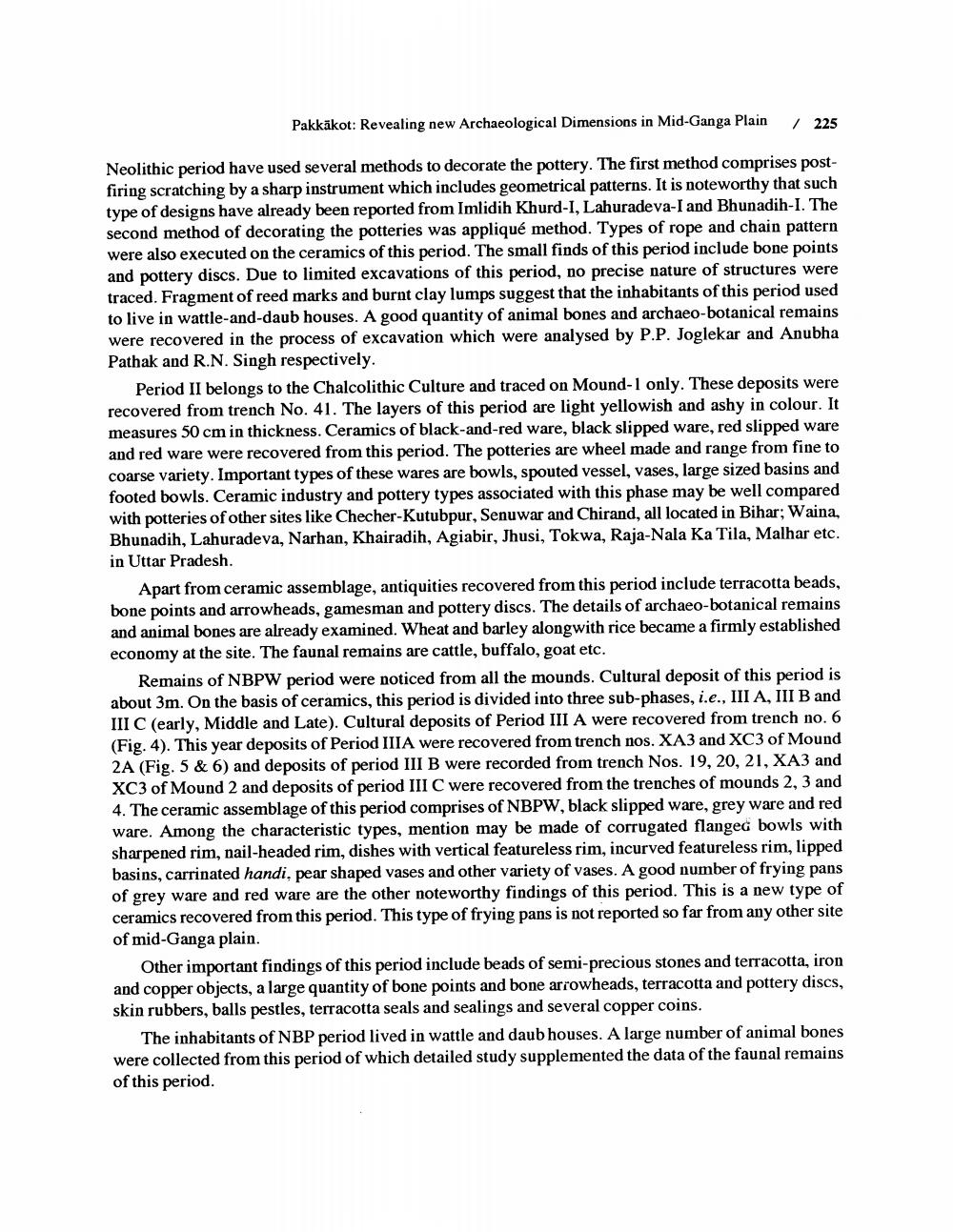________________
Pakkäkot: Revealing new Archaeological Dimensions in Mid-Ganga Plain
/ 225
Neolithic period have used several methods to decorate the pottery. The first method comprises postfiring scratching by a sharp instrument which includes geometrical patterns. It is noteworthy that such type of designs have already been reported from Imlidih Khurd-I, Lahuradeva-I and Bhunadih-I. The second method of decorating the potteries was appliqué method. Types of rope and chain pattern were also executed on the ceramics of this period. The small finds of this period include bone points and pottery discs. Due to limited excavations of this period, no precise nature of structures were traced. Fragment of reed marks and burnt clay lumps suggest that the inhabitants of this period used to live in wattle-and-daub houses. A good quantity of animal bones and archaeo-botanical remains were recovered in the process of excavation which were analysed by P.P. Joglekar and Anubha Pathak and R.N. Singh respectively.
Period II belongs to the Chalcolithic Culture and traced on Mound-1 only. These deposits were recovered from trench No. 41. The layers of this period are light yellowish and ashy in colour. It measures 50 cm in thickness. Ceramics of black-and-red ware, black slipped ware, red slipped ware and red ware were recovered from this period. The potteries are wheel made and range from fine to coarse variety. Important types of these wares are bowls, spouted vessel, vases, large sized basins and footed bowls. Ceramic industry and pottery types associated with this phase may be well compared with potteries of other sites like Checher-Kutubpur, Senuwar and Chirand, all located in Bihar; Waina, Bhunadih, Lahuradeva, Narhan, Khairadih, Agiabir, Jhusi, Tokwa, Raja-Nala Ka Tila, Malhar etc. in Uttar Pradesh.
Apart from ceramic assemblage, antiquities recovered from this period include terracotta beads, bone points and arrowheads, gamesman and pottery discs. The details of archaeo-botanical remains and animal bones are already examined. Wheat and barley alongwith rice became a firmly established economy at the site. The faunal remains are cattle, buffalo, goat etc.
Remains of NBPW period were noticed from all the mounds. Cultural deposit of this period is about 3m. On the basis of ceramics, this period is divided into three sub-phases, i.e., III A, III B and III C (early, Middle and Late). Cultural deposits of Period III A were recovered from trench no. 6 (Fig. 4). This year deposits of Period IIIA were recovered from trench nos. XA3 and XC3 of Mound 2A (Fig. 5 & 6) and deposits of period III B were recorded from trench Nos. 19, 20, 21, XA3 and XC3 of Mound 2 and deposits of period III C were recovered from the trenches of mounds 2, 3 and 4. The ceramic assemblage of this period comprises of NBPW, black slipped ware, grey ware and red ware. Among the characteristic types, mention may be made of corrugated flanges bowls with sharpened rim, nail-headed rim, dishes with vertical featureless rim, incurved featureless rim, lipped basins, carrinated handi, pear shaped vases and other variety of vases. A good number of frying pans of grey ware and red ware are the other noteworthy findings of this period. This is a new type of ceramics recovered from this period. This type of frying pans is not reported so far from any other site of mid-Ganga plain.
Other important findings of this period include beads of semi-precious stones and terracotta, iron and copper objects, a large quantity of bone points and bone arrowheads, terracotta and pottery discs, skin rubbers, balls pestles, terracotta seals and sealings and several copper coins.
The inhabitants of NBP period lived in wattle and daub houses. A large number of animal bones were collected from this period of which detailed study supplemented the data of the faunal remains of this period.




